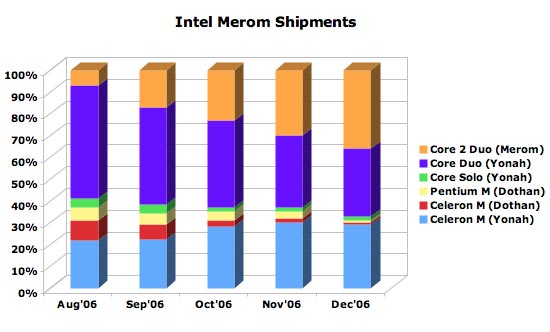Mobile CPU Wars: Core 2 Duo vs. Core Duo
by Anand Lal Shimpi on August 3, 2006 9:25 AM EST- Posted in
- CPUs
Model Numbers Galore
Just like the outgoing Core Duo processor, Intel's Core 2 Duo lineup uses its arbitrarily determined model number system. While the previous Core Duo chips were all numbered as T2000 series processors, the new Core 2 Duos are all T7000 and T5000 chips. The T5000 models feature a 2MB L2 cache while the T7000 have a full 4MB L2, and as the name implies all of these CPUs are dual core.
The table below features all of the Core 2 Duo parts that will be available this quarter:
| CPU | Clock Speed | FSB | L2 Cache | Price |
Intel Core 2 Duo T7600 |
2.33GHz |
667MHz |
4MB |
$637 |
Intel Core 2 Duo T7400 |
2.16GHz |
667MHz |
4MB |
$423 |
Intel Core 2 Duo T7200 |
2.00GHz |
667MHz |
4MB |
$294 |
Intel Core 2 Duo T5600 |
1.83GHz |
667MHz |
2MB |
$241 |
Intel Core Duo T2700 |
2.33GHz |
667MHz |
2MB |
$637 |
Intel Core Duo T2600 |
2.16GHz |
667MHz |
2MB |
$423 |
Intel Core Duo T2500 |
2.00GHz |
667MHz |
2MB |
$294 |
Intel Core Duo T2400 |
1.83GHz |
667MHz |
2MB |
$241 |
Intel Core Duo T2300 |
1.66GHz |
667MHz |
2MB |
$241 |
Intel Core Duo T2300E* |
1.66GHz |
667MHz |
2MB |
$209 |
*Note: These CPUs lack Intel Virtualization Technology (VT) support)
The Core 2 Duo lineup that's being introduced this quarter shows one common theme: price parity. The new Core 2 Duo processors are available at the same clock speeds as the now "old" Core Duo processors and at the same price. For the same price you do get a faster CPU and in most cases twice the L2 cache, but we'll save the performance and battery life comparisons for later on in the review.
The point of Intel's pricing strategy with Core 2 Duo on the mobile side is to quickly phase out out Core Duo and replace it with Core 2 Duo. The chart below details Intel's plans to ramp Core 2 Duo in its mobile segment:

You'll note that Intel is quite aggressive with ramping Core 2 Duo up, but going into 2007 over a quarter of Intel's mobile processor shipments will still be Core Duo.










46 Comments
View All Comments
IntelUser2000 - Saturday, August 5, 2006 - link
Correct. Lots of the benchmarks show 10% advantage for Core 2 Duo over Core Duo. The only 10% advantage 4MB L2 over 2MB L2 is in a single app.
bob661 - Thursday, August 3, 2006 - link
Video makes ALL the difference in the world.monsoon - Thursday, August 3, 2006 - link
I'm in the market for a mini PC to do video trancode, and I was considering the MEROM chip to compare to YONAH......in the end, given the right graphic card ( add ATI X1400 series or higher here ) with hardware embedded transcode features, i guess the YONAH fits my bill just right.
And i get to pay 100$ or 200$ less than the same computer with a MEROM which could not offer me better on the video side...
What do you think ?
bob661 - Thursday, August 3, 2006 - link
I would get the best video you can get with the cash saved from getting the Memron.Tiamat - Thursday, August 3, 2006 - link
Whats the difference between the Intel Core Duo T2300E* and the Intel Core Duo T2300E?I see a difference in price, but not specs. The page in the article does not address the asterisk...
Anand Lal Shimpi - Thursday, August 3, 2006 - link
The asterisk means that the CPU lacks support for Intel Virtualization Technology (VT). I had the note on Page 3 but I forgot to include it on Page 2 :) Thanks for the heads up :)Take care,
Anand